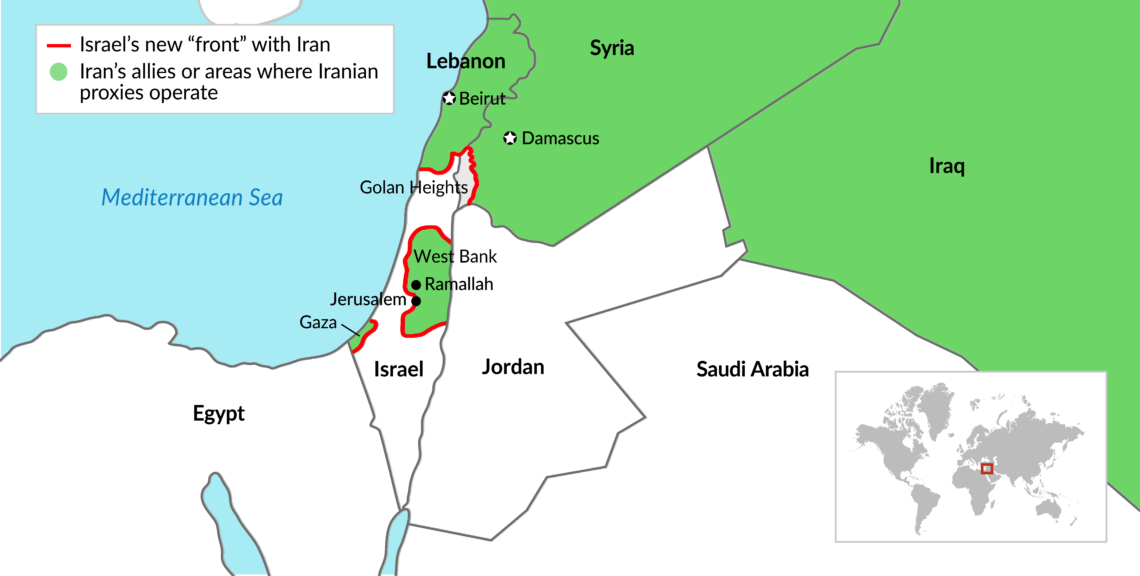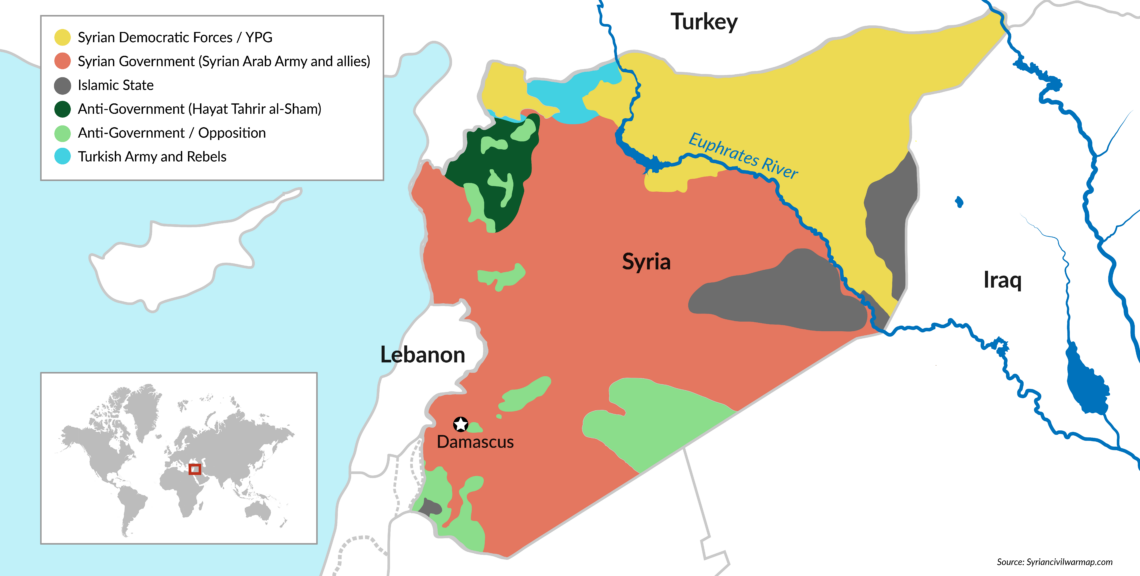Syria heads toward renewed conflict
Daesh’s imminent defeat in Syria has brought new tensions to the fore. Iran now has proxies and allies right next door to Israel, while the U.S. has committed to a long-term military presence. Russia’s main objective continues to be securing its Syrian base.

In a nutshell
- The U.S., Turkey, Iran and Russia are all raising their military presence in Syria
- Each has goals that are incompatible with the others’
- Though peace is possible, continued conflict looks much more likely
Events are coming to a head in Syria now that the imminent defeat of Daesh (also known as Islamic State) has taken the lid off simmering regional tensions. Iran and its allies – flush with the glow of victory over Daesh and others – are bolstering their presence in Syria, close to the Israeli border and the Golan Heights. These dynamics have introduced several big, overarching themes to the Levant’s geopolitical landscape.
Iran’s position
First, Iran has become a de facto military neighbor of Israel along a strip of territory stretching from southern Lebanon to the Golan Heights south of Damascus. In fact, this front now runs all the way to the occupied territories. The new Hamas leadership there, headed by Saleh al-Arouri, met Hassan Nasrallah, the leader of Iran-backed Hezbollah, in the latter’s stronghold of Dahieh in southern Beirut at the end of last October. This little-noticed meeting was crucial in creating this continuous military and political front against Israel, after what Hamas and Hezbollah call the “diversion of the seven-year Syrian war against Daesh.”
The key here is Hamas’s internal dynamics: the current leadership emerged from the organization’s military wing, which, as the “internally based” element inside the occupied territories, did not always see eye to eye with the “externally based” political wing. The latter operated from Qatar and later Istanbul. In fact, Hamas forces at one point fought alongside Sunni jihadists against Hezbollah in Syria. That is all in the past. Now this unified military front across national borders has Tehran’s backing. Thousands of Iranian missiles have been supplied to Hezbollah, and the alliance is ready to do battle against Israel. Crucial to this strategy is the Iran-controlled land corridor stretching from Afghanistan in the east to the Mediterranean in Lebanon to the west, passing through Iraq and Syria.
Washington’s commitment
The second overarching theme is the United States’ commitment to remain in Syria long-term. Crucially, one of the objectives of this on-the-ground presence (currently 2,000 personnel, up from 500 a year ago) is to diminish Iran’s influence in the region and to prevent it from threatening Israel. Another goal is to complete the defeat of Daesh – the Trump administration wants to avoid the same kind of premature withdrawal that occurred in Iraq in 2009 under President Barack Obama and gave Daesh the space to emerge. The third objective is securing a political process that leads to a settlement without President Bashar al-Assad.
The U.S. strategy in Syria and the Levant has tilted decisively toward military options.
These are ambitious targets that could lead to conflicts with Iran and its various regional militias, President al-Assad’s own army, and potentially Russia, if Moscow were to continue to back the Assad regime as strongly as it has so far. However, this may not be the case once Russia’s key interests – its military bases in the country – are secured.
U.S. Secretary of State Rex Tillerson has indicated that his country’s military presence will remain “conditions-based.” Three conclusions can be drawn from this: first, the U.S. strategy in Syria and the Levant has tilted decisively toward military options. It is adopting an aggressive posture as it seeks to confront Iran head-on. Second, Israel and the U.S. harbor very serious doubts about reported Russian assurances that Iran will not launch attacks from Syria. Third, the U.S. mission is open-ended. That it is “conditions-based” likely means the U.S. will send more troops, build permanent bases, and aim to create a friendly, or at least nonhostile, ecosystem.
Turkey-NATO tension
This leads to the third overarching theme: the brewing conflict between Turkey, the U.S. and NATO over the semiautonomous Kurdish enclave in northern Syria. This Lebanon-sized area is controlled by the Kurdish People’s Protection Units (YPG). They are a battle-hardened, secular militia that effectively did all the fighting against Daesh, defeating it and ending up in control of that border strip. Whereas Turkey designated the YPG as a terrorist organization because of its reported links with the outlawed Kurdistan Workers’ Party (PKK), the U.S., NATO and the European Union have treated them as close allies. This has created huge tensions with Ankara.
Facts & figures
Areas of control in Syria

While the U.S. announced that it will be training 30,000 “Border Force” fighters in the Kurdish-controlled region, Turkey began military operations against the YPG. These moves, inside northern Syria, raise the serious possibility of an accidental clash between two NATO members, as well as a lasting political fissure between Turkey and the rest of NATO.
An active, long-term U.S. presence in Syria probably would require setting up facilities in the YPG-controlled region. If Turkey continues its military incursions there and keeps undermining the viability of the YPG, it will be obstructing a key NATO foreign policy goal. It will also be undercutting a tool for Israel to protect itself against an Iran-backed attack.
Astana Process
The fourth overarching theme is the so-called “Astana Process,” sponsored by Russia, Iran and Turkey to effectively supplant the Geneva Process, backed by the U.S. and United Nations, which went nowhere. Until now, the Astana Process has seemed on track. However, Russia’s insistence on inviting Syria’s Kurds and the YPG to the meetings renewed tensions between Moscow and Ankara. Turkey has been pressing Russia to exclude any Kurdish representation at the talks. Russia, which has also supported the YPG, has refused to budge. Turkey, therefore, seems isolated, having defined its key geopolitical objective through the single prism of the Kurdish insurgency.
Arab powers that were considered essential up till now no longer seem relevant.
Arab absence
The fifth overarching theme is the absence of any Arab state involvement in these machinations. It speaks volumes that the troika leading the Astana Process does not include any Arab players, though it could determine the future of a key Arab country. This reveals another crucial dynamic: Arab powers that were considered essential up till now no longer seem relevant. The marginalization of Arab states will strengthen the hand of cross-border, non-state actors, such as Hezbollah, Hamas and the Iran-backed Iraqi Popular Mobilization Front, all of which are likely to play the key roles in any conflict along the Syria-Israel border.
Russia-U.S. tensions
The final overarching theme is the emerging Russo-American conflict over Syria. Secretary Tillerson stated that one of the objectives of the U.S.’s long-term presence in Syria will be to curb Russian influence. Both countries will now have a permanent, on-the-ground military presence in Syria with vastly differing objectives, strategic tools, allies and means. There will be ample room for friction.
Diplomatically, the biggest tensions will probably appear over the $200 billion reconstruction bill for post-Daesh Syria. The U.S.’s position is that it will not support reconstruction unless Russia cooperates in the “political process” – a euphemism for the removal of President Assad. The Russians may acquiesce to this for the right concessions, especially the guaranteed security of their warm water naval base at Tartus and air base at Hmeimim. Iran will strongly oppose any move to drop Mr. Assad, upon whom its operations in the Levant depend.
Moscow may see Tehran’s activities in Syria as a tool to keep the U.S. at bay.
While Moscow also wants Iran’s influence to wane, it may see Tehran’s activities in Syria as a tool to keep the U.S. at bay. Economic considerations may also play a significant role: the oil fields of eastern Syria are now largely within the semiautonomous Kurdish region. This will likely benefit U.S. commercial interests – potentially also leading to a long-term American business presence.
Scenarios
It is hard not to conclude that the central scenario is further conflict in Syria. It could take the form of a war along the unified border between Iran’s proxies and Israel (and possibly the U.S.), a continuous low-intensity military conflict in the Kurdish-controlled north with Turkey, or a combination of both.
Another possibility is that the Astana Process will produce an agreement that the U.S. can accept. If such a settlement is then given international support, it could potentially be ratified as a Geneva Process agreement, allowing a loose confederation to be formed in Syria. With Russian bases on the coast and U.S. interests in the north and northeast, the two sides could decide to tolerate each other.
Iran, in this scenario, would be left out, giving it an incentive to destabilize Syria. Along with the Russia-Turkey disagreement over Kurdish involvement in the Astana Process, Russia-U.S. tension on a host of matters, and the posture of Iran’s allies and proxies in the region, the scenario for continued conflict seems more likely.








